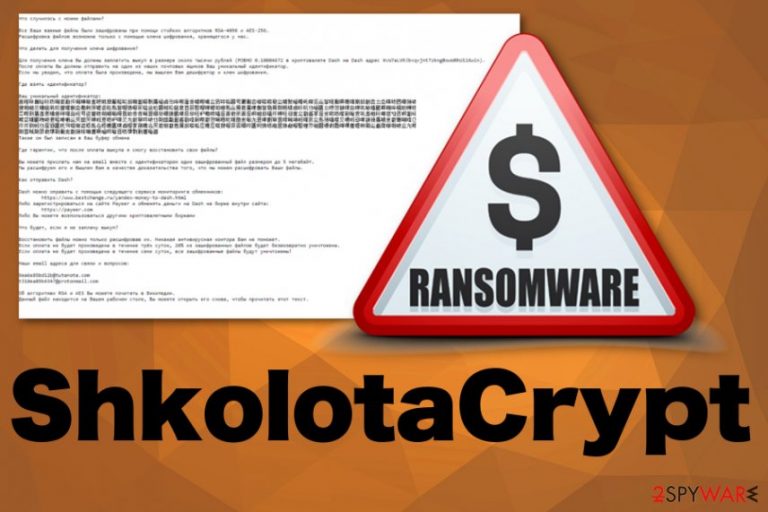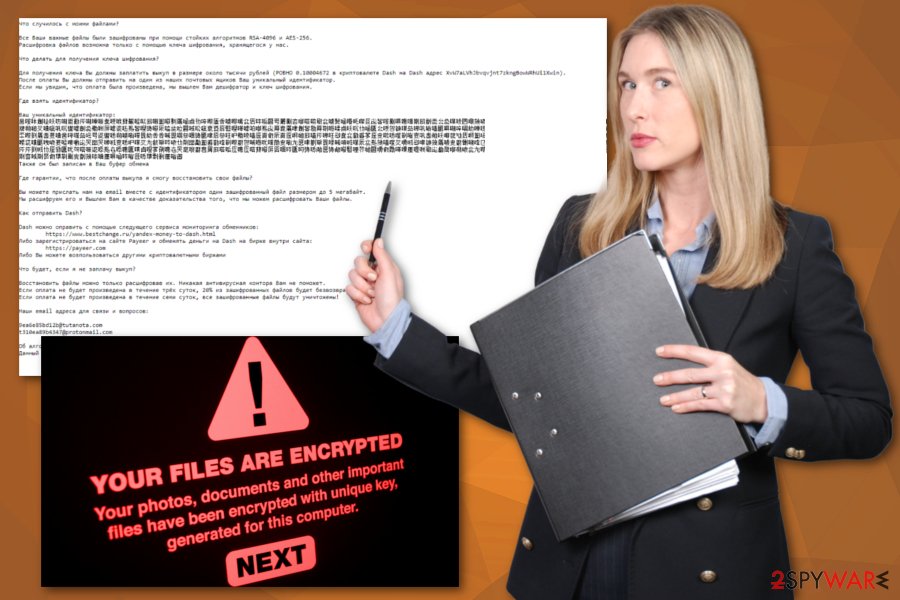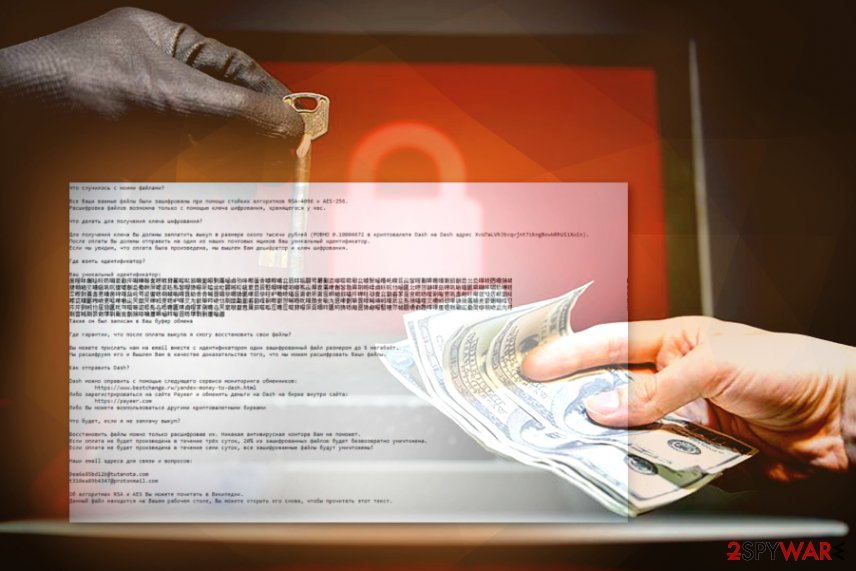ShkolotaCrypt ransomware (Removal Instructions) - Decryption Steps Included
ShkolotaCrypt virus Removal Guide
What is ShkolotaCrypt ransomware?
ShkolotaCrypt ransomware – cryptovirus targeting Russian-speaking victims that uses RSA and AES encryption algorithms

ShkolotaCrypt ransomware is the file-locking threat that delivers READ ME!!!.txt file with the ransom note in Russian and demands a thousand rubles in Dash cryptocurrency for the alleged decryption key. The ransom equals to about 0,1 Dash for the file recovery. However, these extortionists can pretend to have the needed decryption key or tool and claim to restore the affected data after the payment, but disappear after the ransom gets paid instead. Although there is no clear relation with other threats, the file marker that ShkolotaCrypt adds to encoded files – .crypted is known in association with CryptoLocker and GlobeImposter.
Although ShkolotaCrypt ransomware is a threat targeting Russian-speaking victims, this is only based on the ransom note contents. You can become a victim of this cryptovirus no matter the location or language you are speaking. So be aware that paying the ransom is never a good option.
| Name | ShkolotaCrypt |
|---|---|
| Type | Ransomware[1] |
| File extension | .crypted |
| Ransom note | READ ME!!!.txt |
| Encryption method | RSA-4096 and AES-256[2] |
| Ransom amount | ˜0,1 Dash – 1000 rubles |
| Distribution | Exploits vulnerabilities to enter the targeted system or spread via infected spam email attachments |
| Elimination | Employ FortectIntego for ShkolotaCrypt ransomware removal |
ShkolotaCrypt ransomware infects the system via unprotected configurations or spam email attachments and exploiting particular flaws of the system. The initial ransomware attack stars immediately after the infiltration when this virus starts to scan the machine for files that can get encrypted.
This virus also checks the location of the infected device to make sure that it is the correct ShkolotaCrypt ransomware target. During this scan, the system is also checked for previous possible file encryptions or malware attacks. Then data is chosen for encryption. Files in more than 60 differen formats get encoded and marked:
- .avi,
- .bmp,
- .doc,
- .docx,
- .gif,
- .jpeg,
- .mp4,
- .mpeg,
- .pages,
- .pdf,
- .png,
- .ppt,
- .pptx,
- .rar,
- .rtf,
- .txt,
- .wmv,
- .xlsx,
- .zip.
ShkolotaCrypt ransomware virus employs RSA-4096 and AES-256 encryption algorithms for this process of making users' data locked and unopenable. Then, the ransom can be demanded, and these criminals claim to have one and an only tool capable of recovering their files. Although these claims may be false, data recovery after such virus attacks is not always possible.
ShkolotaCrypt ransomware developers are criminals who focus on getting your money, so even based on the test decryption that is offered in the ransom note, hackers shouldn't be considered as trustworthy. There is no legitimate proof that those criminals can decrypt your data.

The ransom note that is placed on the desktop and in every fonder with encoded files, ShkolotaCrypt ransomware developers wrote all the information about this attack and payment, decryption possibilities. A text file named READ ME!!!.txt is in Russian, but the translation reads the following:
What happened to my files?
All your important files were encrypted using strong RSA-4096 and AES-256 algorithms.
File decryption is possible only with the help of the encryption key stored by us.
What to do to get the encryption key?
To obtain the key, you must pay a ransom in the amount of about a thousand rubles (EXACTLY 0.10004672 in the Dash cryptocurrency at Dash address XvW7aLVhJbvqvjnt7zkngBowWRhUi1Xwin ).
After payment you must send your unique identifier to one of our mailboxes.
If we see that the payment has been made, we will send you a descrambler and encryption key.
Where to get the ID?
Your unique identifier:
㖖 㗌 㕲 㔅 㖉 㕭 㕫 㗅 㖛 㖛 㔦 㕂 㗅 㖦 㖘 㗯 㖟 㗋 㔑 㔑 㔮 㗰 㕽 㕏 㗙 㔩 㗶 㔌 㔌 㕒 㕆 㕩
It was also recorded in your buffer exchange
Where is the guarantee that after paying the ransom I can recover my files?
You can send us an email with an identifier one encrypted file up to 5 megabytes.
We will decrypt it and will send you as proof that we can decrypt your files.
How to send Dash?
Dash can be sent using the following monitoring service for exchangers:
https://www.bestchange.ru/yandex-money-to-dash.html
Or register on the Payeer website and exchange money for Dash on the stock exchange inside the website:
https: // payeer. com
Or you can use itOther cryptocurrency exchanges
What will happen if I do not pay the ransom?
You can restore files only by decrypting them. No antivirus office will help you.
If payment is not made within three days, 20% of the encrypted files will be irretrievably destroyed.
If payment is not made within seven days, all encrypted files will be destroyed!
Our email addresses for contacts and questions:
9ea6e85bd12b@tutanota.com
t310ea89b4347@protonmail.com
You can read about RSA and AES algorithms in Wikipedia.
This file is on your desktop, you can open it again to read this text.
ShkolotaCrypt ransomware creators provide contact emails and all the instructions for paying the ransom. However, we, as other experts[3] always recommend staying away from contacting attackers and paying the ransom since this is not the method that gives positive results.
You should remove ShkolotaCrypt ransomware instead and clean the machine thoroughly before recovering the data affected by the cryptovirus. You can do that with anti-malware tools and programs like FortectIntego. A full system scan with such programs can indicate all the malicious files and associated applications to help with the thorough virus elimination.
Additionally, you need an automatic ShkolotaCrypt ransomware removal with professional anti-malware tools because various files get installed on the machine and programs added or disabled by this threat. Updater.exe, sharp.pdb., styler.pdb can be found as malicious on the computer.[4]

Possible ShkolotaCrypt ransomware attack and distribution involves particular WinRar vulnerability
Once the sample of ShkolotaCrypt ransomware virus got analyzed, more details came to light regarding the spreading methods of this crypto malware. WinRar vulnerability that gets exploited by the virus creators. This high-profile vulnerability has been used for more than twenty years, and at the start of 2019, threatened 500 million users all over the world.
This flaw is related to UNACEV2.DLL library that needed an update since 2005. Each time the system gets rebooted ACE archives get unpacked, and attackers assign the place to load the archive file. Once the malicious file comes to the Startup directory, it can launch malicious activities like infiltrating ShkolotaCrypt ransomware on the targeted device.
When WinRAR 5.70 beta 1 was released in January, particular vulnerabilities (CVE-2018-20250, CVE-2018-20251, CVE-2018-20252, and CVE-2018-20253) got fixed, and ACE format was eliminated. However, when people use the older versions, ransomware and other malware can use the flaw to get on the PC. Update the tool to avoid any infections because various malware creators can exploit this flaw.
Common ways of cryptovirus distribution
Besides all the vulnerability exploitation, breaking through unprotected RDP and other malware, there is a more common method used to deliver malware that locks files and demands payments – spam email campaigns. During these phishing attacks, malicious actors can pack their malicious script on the file and attach that as a document to the notification.
Unfortunately, these emails look legitimate and even safe when criminals make them look like notifications from companies or services like FedEx, eBay, and DHL. These emails state about refunds, shipment details, financial information, and documents attached to the email make sense.
However, once the email is opened, the attachment downloaded to the computer, the malicious script gets triggered when the victim opens that text file or launches the executable. This can directly infect the machine with cryptovirus, any other malware that further spreads ransomware or open the backdoor for the remote attacker.
Terminate ShkolotaCrypt ransomware virus and delete all related files
You need to focus on the ShkolotaCrypt ransomware removal and clean the system thoroughly, so all the files added by the virus developers can be deleted and programs disabled. For that, we always recommend scanning the system thoroughly using professional antivirus programs.
Choose the reliable source of software or official provider of the tool and install FortectIntego, SpyHunter 5Combo Cleaner, or Malwarebytes. Then remove ShkolotaCrypt ransomware, other malicious programs or corrupted and infected files by cleaning the machine fully. This virus can also disable security functions or programs and affect the elimination this way, so enter the Safe Mode before scanning.
Getting rid of ShkolotaCrypt virus. Follow these steps
Manual removal using Safe Mode
Ensure the complete ShkolotaCrypt ransomware removal by rebooting the machine in Safe Mode with Networking
Important! →
Manual removal guide might be too complicated for regular computer users. It requires advanced IT knowledge to be performed correctly (if vital system files are removed or damaged, it might result in full Windows compromise), and it also might take hours to complete. Therefore, we highly advise using the automatic method provided above instead.
Step 1. Access Safe Mode with Networking
Manual malware removal should be best performed in the Safe Mode environment.
Windows 7 / Vista / XP
- Click Start > Shutdown > Restart > OK.
- When your computer becomes active, start pressing F8 button (if that does not work, try F2, F12, Del, etc. – it all depends on your motherboard model) multiple times until you see the Advanced Boot Options window.
- Select Safe Mode with Networking from the list.

Windows 10 / Windows 8
- Right-click on Start button and select Settings.

- Scroll down to pick Update & Security.

- On the left side of the window, pick Recovery.
- Now scroll down to find Advanced Startup section.
- Click Restart now.

- Select Troubleshoot.

- Go to Advanced options.

- Select Startup Settings.

- Press Restart.
- Now press 5 or click 5) Enable Safe Mode with Networking.

Step 2. Shut down suspicious processes
Windows Task Manager is a useful tool that shows all the processes running in the background. If malware is running a process, you need to shut it down:
- Press Ctrl + Shift + Esc on your keyboard to open Windows Task Manager.
- Click on More details.

- Scroll down to Background processes section, and look for anything suspicious.
- Right-click and select Open file location.

- Go back to the process, right-click and pick End Task.

- Delete the contents of the malicious folder.
Step 3. Check program Startup
- Press Ctrl + Shift + Esc on your keyboard to open Windows Task Manager.
- Go to Startup tab.
- Right-click on the suspicious program and pick Disable.

Step 4. Delete virus files
Malware-related files can be found in various places within your computer. Here are instructions that could help you find them:
- Type in Disk Cleanup in Windows search and press Enter.

- Select the drive you want to clean (C: is your main drive by default and is likely to be the one that has malicious files in).
- Scroll through the Files to delete list and select the following:
Temporary Internet Files
Downloads
Recycle Bin
Temporary files - Pick Clean up system files.

- You can also look for other malicious files hidden in the following folders (type these entries in Windows Search and press Enter):
%AppData%
%LocalAppData%
%ProgramData%
%WinDir%
After you are finished, reboot the PC in normal mode.
Remove ShkolotaCrypt using System Restore
You may need to use System Restore to recover the machine in a previous state when ransomware was not active
-
Step 1: Reboot your computer to Safe Mode with Command Prompt
Windows 7 / Vista / XP- Click Start → Shutdown → Restart → OK.
- When your computer becomes active, start pressing F8 multiple times until you see the Advanced Boot Options window.
-
Select Command Prompt from the list

Windows 10 / Windows 8- Press the Power button at the Windows login screen. Now press and hold Shift, which is on your keyboard, and click Restart..
- Now select Troubleshoot → Advanced options → Startup Settings and finally press Restart.
-
Once your computer becomes active, select Enable Safe Mode with Command Prompt in Startup Settings window.

-
Step 2: Restore your system files and settings
-
Once the Command Prompt window shows up, enter cd restore and click Enter.

-
Now type rstrui.exe and press Enter again..

-
When a new window shows up, click Next and select your restore point that is prior the infiltration of ShkolotaCrypt. After doing that, click Next.


-
Now click Yes to start system restore.

-
Once the Command Prompt window shows up, enter cd restore and click Enter.
Bonus: Recover your data
Guide which is presented above is supposed to help you remove ShkolotaCrypt from your computer. To recover your encrypted files, we recommend using a detailed guide prepared by 2-spyware.com security experts.If your files are encrypted by ShkolotaCrypt, you can use several methods to restore them:
Data Recovery Pro is the alternative method for file restoring when data backups are not available
When you don't have backups up-to-date, Data Recovery can get handy. Also, this program recovers files deleted accidentally
- Download Data Recovery Pro;
- Follow the steps of Data Recovery Setup and install the program on your computer;
- Launch it and scan your computer for files encrypted by ShkolotaCrypt ransomware;
- Restore them.
Windows Previous Versions can restore affected files
ShkolotaCrypt ransomware encrypts files, and if you use System Restore to fight this virus, Windows Previous Versions can help with encrypted data
- Find an encrypted file you need to restore and right-click on it;
- Select “Properties” and go to “Previous versions” tab;
- Here, check each of available copies of the file in “Folder versions”. You should select the version you want to recover and click “Restore”.
ShadowExplorer as a file recovery method
When Shadow Volume Copies are not affected, users can try ShadowExplorer and recover encrypted data
- Download Shadow Explorer (http://shadowexplorer.com/);
- Follow a Shadow Explorer Setup Wizard and install this application on your computer;
- Launch the program and go through the drop down menu on the top left corner to select the disk of your encrypted data. Check what folders are there;
- Right-click on the folder you want to restore and select “Export”. You can also select where you want it to be stored.
Decrytption is not possible for ShkolotaCrypt ransomware
Finally, you should always think about the protection of crypto-ransomwares. In order to protect your computer from ShkolotaCrypt and other ransomwares, use a reputable anti-spyware, such as FortectIntego, SpyHunter 5Combo Cleaner or Malwarebytes
How to prevent from getting ransomware
Choose a proper web browser and improve your safety with a VPN tool
Online spying has got momentum in recent years and people are getting more and more interested in how to protect their privacy online. One of the basic means to add a layer of security – choose the most private and secure web browser. Although web browsers can't grant full privacy protection and security, some of them are much better at sandboxing, HTTPS upgrading, active content blocking, tracking blocking, phishing protection, and similar privacy-oriented features. However, if you want true anonymity, we suggest you employ a powerful Private Internet Access VPN – it can encrypt all the traffic that comes and goes out of your computer, preventing tracking completely.
Lost your files? Use data recovery software
While some files located on any computer are replaceable or useless, others can be extremely valuable. Family photos, work documents, school projects – these are types of files that we don't want to lose. Unfortunately, there are many ways how unexpected data loss can occur: power cuts, Blue Screen of Death errors, hardware failures, crypto-malware attack, or even accidental deletion.
To ensure that all the files remain intact, you should prepare regular data backups. You can choose cloud-based or physical copies you could restore from later in case of a disaster. If your backups were lost as well or you never bothered to prepare any, Data Recovery Pro can be your only hope to retrieve your invaluable files.
- ^ Ransomware. Wikipedia. The free encyclopedia.
- ^ Encryption algorithm. Webopedia. IT definitions .
- ^ Bedynet. Bedynet. Spyware related news.
- ^ updater.exe analysis. VirusTotal. Online malware scanner.







